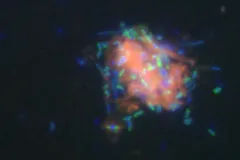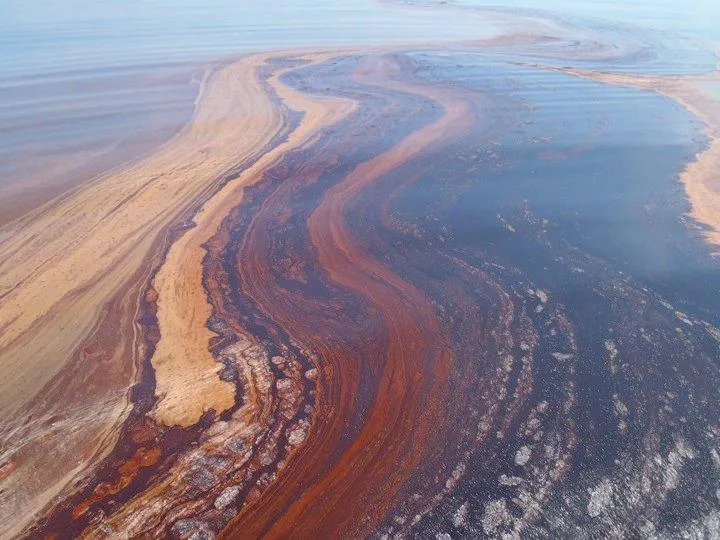A Bacterium's Super Powers

In the wake of the Deepwater Horizon oil spill in April 2010, photos of pelicans, sea turtles, and other Gulf of Mexico wildlife struggling in oil became some of the most publicized and disturbing images following the disaster. Years later, we would learn that exposure to the oil not only caused immediate health concerns and even death, but that animals exposed to the oil may have health conditions that plague them for the rest of their lives. At the time, many assumed that crude oil is a toxic and deadly substance to all forms of life. That is until you consider ocean microbes.
Although most microbes are impacted by oil toxicity like most every other living species, a select group of ocean bacteria are oil lovers. Life in the Gulf of Mexico has exposed them to small traces of oil from natural seeps. Normally scarce in the ocean, they have evolved to take advantage of this unusual resource. Armed with a suite of adaptations that allow them to combat and degrade the usually harmful substance, some even actively seek out the oil sludge using the microbial version of a sense of smell. The bacteria seek out the oil because molecules that usually cause harm are actually wanted as sources of fuel. Just 11 days after the spill, oil-eating microbes were flourishing in the plume of spewing oil coming from the broken wellhead. A month later, they were consuming oil at a rate 60,000-times faster than they would at a natural seep.
Before the Deepwater Horizon oil spill, oceanic microbes were mainly studied in labs. This was a hindrance to understanding how microbes interacted with their environment since the majority of oceanic microbes cannot be successfully grown outside of their natural environment. With the development of new genomic tools, marine microbes could be studied at sea and scientists funded by the Gulf of Mexico Research Initiative soon discovered how diverse and specialized these microbes can be. Here we outline some of the fantastic adaptations that make bacteria thrive in the presence of crude oil.
Degraders
Crude oil is a mixture of thousands of molecules containing mostly hydrogen and carbon, also called “hydrocarbons.” Some hydrocarbons are built as chains, others circle to make ring structures. These ring-form hydrocarbons are toxic to most species that encounter them, but for a select group of bacteria, the hydrocarbons offer a source of fuel that no one else can take advantage of. These hydrocarbon eaters use special molecules, called enzymes, that are able to break apart the strong molecular bonds of the oil molecules. Sometimes the oil-degrading enzymes are secreted by the bacterium, and only after the hydrocarbons have been degraded outside the cell can they be consumed.
Since there are thousands of molecules in oil, bacteria need to be selective as to which molecules they allow to enter their cell. A given bacteria species usually focuses on one or just a handful of the molecules in oil. A ringed hydrocarbon requires a different degrading enzyme than a chained one, meaning there are dozens of different oil-degrading enzymes that act on different molecular structures. Despite the diversity in enzymes, some of the most complicated oil molecules are too difficult for any microbe to degrade, showing that even bacteria have limits to what they can accomplish.
On the Scent
For many oil-loving bacteria, having a keen sense of smell is essential for “sniffing out” any oil in the vicinity. Of course, bacteria do not have noses, they are single-celled organisms and must make do with the machinery they have within the cell. Often, a bacterium is nothing more than a cylindrical cell and a tail that propels it through the water and a bacteria’s nose is actually just a suite of sensitive receptors embedded in their exterior. When even a trace of oil is in the water surrounding them, the receptors pick up the scent and send a signal telling the bacterium’s tail to wriggle in a forward direction, effectively propelling the bacterium towards a tasty meal.
However, not all of the molecules that make up oil are good sources of fuel. Some chemicals in oil are so complicated in structure that even the best oil-degrading bacteria cannot chop them into manageable pieces. When oil is sensed in the environment, a defense against toxic oil molecules is initiated by the microbe, blocking such chemicals from entering and harming the bacterial cell.
Chemical Factories
For water-dwelling bacteria, getting access to the oil is limited by how much is in contact with the water—oil in the interior of the oil mass is impossible to get at. Unable to physically break through the oil, they’ve turned to chemicals to help them consume as much oil as possible.
By secreting detergent-like substances into the oil, oil-loving bacteria are able to break up the mass into small droplets. This increases the amount of oil exposed to the ocean water which enables greater access to bacteria. Scientists call these detergent-like substances “surfactants” and they work because, like hand soap, they are built of molecules that both attract oil on one side and attract water on the other. Wanting to grab on to both water and the oil, the surfactants force the oil to form droplets. Because of their efficiency in breaking up oil slicks, naturally produced surfactants are of high interest to chemical companies in pursuit of a better artificial dispersant. Unlike current dispersants that are made in a lab, surfactants made by bacteria naturally degrade and pose little threat to other wildlife, showing these ingenious little microbes are true super heroes in times of oil spill disasters.
________________
The Ocean Portal receives support from the Gulf of Mexico Research Initiative (GoMRI) to develop and share stories about GoMRI and oil spill science. The Gulf of Mexico Research Initiative (GoMRI) is a 10-year independent research program established to study the effect, and the potential associated impact, of hydrocarbon releases on the environment and public health, as well as to develop improved spill mitigation, oil detection, characterization, and remediation technologies.
For more information, visit http://gulfresearchinitiative.org


